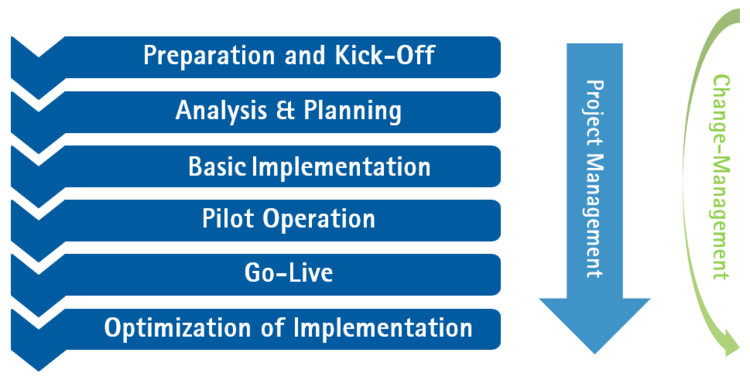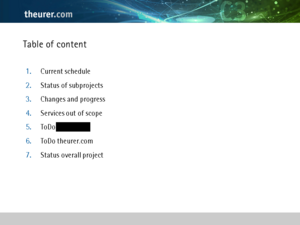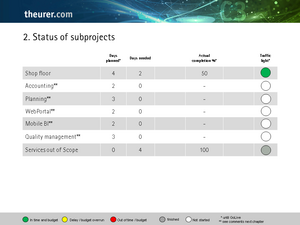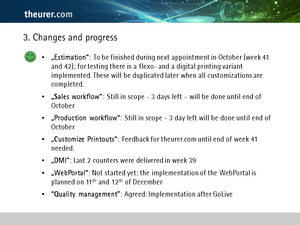Project Implementation
Rolling out new, comprehensive ERP software is a large and significant project for any company - and not an easy one. Some of our new customers have experience implementing an ERP system, but for most it's a completely new project and for many it's difficult to understand. For us, ERP implementations are "daily business" and we know what needs to be done, what the challenges are and how to manage project risks. Over the years, we have developed our own approach to C3 launches. We use recognized project management standards, such as Prince2, and continually review and refine this approach.
Overview of the stages:
Project Stages
Project Start
As a first step after the commercial agreement, you will receive our implementation manual. In parallel, we work on our preparation for the project. At the end of the respective project preparations is the joint kick-off.
Preparation
This is a mixture of explanations on project flow, to-dos that you can already prepare for your company, and questions for you. Many points in the implementation manual are simple, others are complex; all of them have a great influence on your future C3 processes. You will answer and prepare the points that are clear to you; the unclear points will be discussed and worked on together with us after the actual project kick-off. For each point, we describe the latest project phase in which decisions have to be made.
theurer.com project team
In the meantime, we also put together our project team. In a project, we always fill the typical project roles – depending on the project size, roles may also be filled in "personal union".
Project Manager
The project manager manages the project scope, the schedule as well as change requests.
Solution Architect
Our solution architects analyze your companies processes and design solutions according to your needs. This includes all different possibilities of customizing as well as training priorities. They create specifications of those solutions, that will then be executed by our consultants or themselves.
Our solution architects can be considered to be experts of our software and your industry. They have many years of experience in the industry and can thus not only help with software-related questions but also do general business consulting and provide "best practice".
Consultant
Our consultants o the main part of the implementation work. The consultants are ranked as senior and junior consultants. Senior consultants also act as project leaders after the solution architects have finished their work. The work packages created by the solution architects will be distributed to them according to their professional focus and level. By using this strategy, we can incorporate even new employees, as they are first trained to be experts in one of our modules, after which they will broaden their knowledge.
Software Developer
Our software developers usually are not in direct contact with a customer. They develop new functionality based on tasks that are created by customer requests, improvement suggestions or based on our internal strategy for the future. In special cases though, our developers also work closely together with our customers to fulfill special tasks – like connecting a robotic line or a high bay warehouse.
Kick-Off
As soon as you have worked through all the points in the implementation manual – no matter if they were really answered or deferred – it's time for the actual project kick-off. Your project team and our project team "officially" start the project and discuss the following points, among others:
- Rough time frame
- Subdivision into sub-projects with budget and priority
- Open points from implementation manual
- Division of labour and respective to-dos
- Scheduling the on-site appointments
Analysis & Planning
Data Import
In the project, we make a distinction between transferring master data and transferring transaction data to begin with. Master data includes data such as customers, suppliers, articles, tools, materials or similar elements. Transaction data is the data that is newly created on a daily basis, i.e. jobs, turnover, inventory, etc. Both types of data can fundamentally be transferred. Depending on data quality, data structure, data volume, data availability and cost/benefit ratio, we decide together with our project team which data will be automatically transferred, which data may need to be newly recorded or completed and which data is only available in an archive system.
Process Specification
Our project team – above all the solution architect – will work with you and your key users to create a common thread through your new system. It defines which areas of C3 you will use and how. We have best-practice processes for practically all business processes, which have proven their worth and have been continuously refined in the course of the projects. Often there are variations in detail, which have certain characteristics, for example, and are then selected to best suit your business model. Based on these best practice processes should run in C3 at the real start within the basic implementation and which adjustments should be made afterwards in the optimization implementation.
By basic implementation we refer to the introduction of the functionalities that are absolutely necessary for a real start. By optimization implementation we refer to the optimization of these functionalities towards the overall project goals.
By classifying all to-dos in basic/optimization, clear prioritization is possible when the real start date approaches. In addition, users are usually better able to assess the necessity or the benefits of certain adaptions once they have worked with the system for some time and are familiar with the concepts.
Basic Implementation
The most complex phase is described fastest. Everything that has been specified, defined and planned so far has to be implemented step by step. Data is transferred, processes implemented, settings configured and adjustments programmed. All areas of the system are tested.
More and more end users are trained in the processes – depending on the concept – by us or by your key users.
Pilot Operation
The pilot operation is the dress rehearsal before the real start. All users have been trained in your processes and must now put your processes through their paces in a final practical test.
Usually this means that certain exemplary real orders are processed completely in C3 in addition to the legacy system and the results are validated in C3. This means, for example, that the concrete pallet notes for a real order from the legacy system and from C3 are printed, compared, but the pallet is still labelled with the printout of the legacy system.
With our User Activity Board, you can see exactly which users are actually practicing your business processes to what extend and which users are not.
Go-Live
Basically, different scenarios are possible for a successful real start. The two most popular are the "Big Bang" and the "Rolling Start".
Rolling Live Start ("Iterative Introduction")
In this scenario, you agree upon two deadlines. By the first deadline, all the new business transactions (i.e. jobs, orders...) are only entered and edited in C3. Those business transactions that are currently open are still processed (i.e. produced, delivered and estimated)in the old system. Depending on throuhput times, you agree upon a second deadline a few days or a few weeks in advance. The number of open business transactions should be far lower by then and you now enter those business transactions that are still open in the old system once in C3. The old system is only used as an archive from this point onwards. C3 is therefore slowly ramped up after the first deadline, while the role of the old system is continuously scaled back.
Optimization of Implementation
After the real start has been successful and the most urgent to-dos have been completed, the optimization implementation starts. With better plausability, higher accuracy or automation, users' daily working routine becomes more comfortable and efficiency increases.
Your capacity load due to project participation
Example of a rough project plan
Project Management
In our superordinate multi-project management we coordinate the concrete assignments of your project team and agree on dates with you. In concrete project management, we plan and supervise the adherence to budget and deadlines for all sub-projects, record to-dos for all adaptions, training seminars, specifications and regularly readjust priorities with you.
Before on-site assignments of our consultants, you will receive an agenda with your to-dos for the preparation, the project employees that are needed and what is to be achieved at the end of the assignment.
The most important point here is our status report. This is a summary of the current project status, target/actual comparison, completed points and recommendations for action.

















